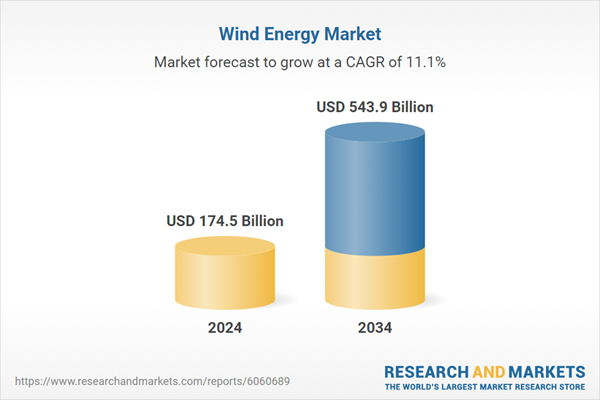The Wind Energy Market was valued at USD 174.5 billion in 2024, and is projected to reach USD 543.9 billion by 2034, rising at a CAGR of 11.1%. Growth is primarily fueled by significant developments in Asia, Europe, and North America, alongside rising investments in offshore wind projects. As the demand for renewable energy surges, wind power now contributes over 10% of the global electricity supply. Increasing reliance on cost-efficient, high-capacity turbines and advanced energy-producing designs is accelerating market penetration. Continuous innovations in materials, aerodynamics, and digitalization are improving turbine efficiency, leading to enhanced performance and greater adoption.
With several countries transitioning toward cleaner energy, wind energy deployment is expanding across China, Brazil, and Australia. Governments worldwide are setting ambitious targets for wind farm development, supported by regulatory incentives that strengthen market growth. The integration of advanced technologies, including sensors, data analytics, and machine learning, is optimizing maintenance and turbine efficiency. Independent Power Producers focusing on wind and other renewables are leveraging these innovations to expand their portfolios, particularly in emerging markets.
The wind energy market is segmented based on components into turbines, support structures, electrical infrastructure, and others. The turbine segment is set to surpass USD 131 billion by 2034 as the industry shifts toward larger, high-capacity turbines. Advanced floating platforms are resolving offshore turbine anchoring challenges, enabling deployment in deeper waters without relying on seabed structures. Enhanced durability and performance-driven designs are further reinforcing turbine adoption across key regions.
By installation type, the market is divided into onshore and offshore segments, with onshore wind energy holding a 64.2% share in 2024. Economic expansion, energy security concerns, and carbon emission reduction goals are driving onshore wind adoption. Modern rotor configurations are improving blade positioning, significantly increasing energy output. New materials and cutting-edge blade designs are enhancing efficiency while reducing maintenance requirements, making onshore wind energy a widely preferred solution.
In the United States, the wind energy market generated USD 11.7 billion in 2022, USD 8.6 billion in 2023, and USD 17.2 billion in 2024. The North American wind energy sector is expected to grow at a compound annual growth rate exceeding USD 52 billion by 2034. Market expansion is propelled by policy support, technological innovations, and evolving industry dynamics. Advancements in grid integration and energy storage solutions are enhancing wind power stability and reliability, further driving adoption across the region.
This product will be delivered within 2-4 business days.
With several countries transitioning toward cleaner energy, wind energy deployment is expanding across China, Brazil, and Australia. Governments worldwide are setting ambitious targets for wind farm development, supported by regulatory incentives that strengthen market growth. The integration of advanced technologies, including sensors, data analytics, and machine learning, is optimizing maintenance and turbine efficiency. Independent Power Producers focusing on wind and other renewables are leveraging these innovations to expand their portfolios, particularly in emerging markets.
The wind energy market is segmented based on components into turbines, support structures, electrical infrastructure, and others. The turbine segment is set to surpass USD 131 billion by 2034 as the industry shifts toward larger, high-capacity turbines. Advanced floating platforms are resolving offshore turbine anchoring challenges, enabling deployment in deeper waters without relying on seabed structures. Enhanced durability and performance-driven designs are further reinforcing turbine adoption across key regions.
By installation type, the market is divided into onshore and offshore segments, with onshore wind energy holding a 64.2% share in 2024. Economic expansion, energy security concerns, and carbon emission reduction goals are driving onshore wind adoption. Modern rotor configurations are improving blade positioning, significantly increasing energy output. New materials and cutting-edge blade designs are enhancing efficiency while reducing maintenance requirements, making onshore wind energy a widely preferred solution.
In the United States, the wind energy market generated USD 11.7 billion in 2022, USD 8.6 billion in 2023, and USD 17.2 billion in 2024. The North American wind energy sector is expected to grow at a compound annual growth rate exceeding USD 52 billion by 2034. Market expansion is propelled by policy support, technological innovations, and evolving industry dynamics. Advancements in grid integration and energy storage solutions are enhancing wind power stability and reliability, further driving adoption across the region.
Comprehensive Market Analysis and Forecast
- Industry trends, key growth drivers, challenges, future opportunities, and regulatory landscape
- Competitive landscape with Porter’s Five Forces and PESTEL analysis
- Market size, segmentation, and regional forecasts
- In-depth company profiles, business strategies, financial insights, and SWOT analysis
This product will be delivered within 2-4 business days.
Table of Contents
Chapter 1 Methodology & Scope
Chapter 2 Executive Summary
Chapter 3 Industry Insights
Chapter 4 Competitive landscape, 2024
Chapter 5 Market Size and Forecast, by Component, 2021-2034 (USD Million)
Chapter 6 Market Size and Forecast, by Turbine Rating, 2021-2034 (USD Million & MW)
Chapter 7 Market Size and Forecast, by Installation, 2021-2034 (USD Million & MW)
Chapter 8 Market Size and Forecast, by Region, 2021-2034 (USD Million & MW)
Chapter 9 Company Profiles
Companies Mentioned
The companies featured in this Wind Energy market report include:- Bergey Windpower
- CSSC Offshore Wind Power
- Doosan Corporation
- EOLINK
- Envision Group
- GE Vernova
- Goldwind
- Hitachi Ltd.
- Mingyang Smart Energy Group
- Nordex SE
- Siemens Gamesa Renewable Energy
- Sinovel Wind Group
- Shanghai Electric
- Vestas
Table Information
| Report Attribute | Details |
|---|---|
| No. of Pages | 160 |
| Published | February 2025 |
| Forecast Period | 2024 - 2034 |
| Estimated Market Value ( USD | $ 174.5 Billion |
| Forecasted Market Value ( USD | $ 543.9 Billion |
| Compound Annual Growth Rate | 11.1% |
| Regions Covered | Global |
| No. of Companies Mentioned | 15 |









